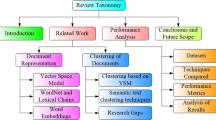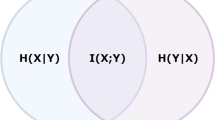Abstract
To address the deficiency in semantic representations of medical texts and achieve the clustering of PubMed database retrieval results, this study presented a method to construct a fusion matrix using text similarity measures. Similarity relations between phrases, texts, and the content of phrases and texts were combined to create a fusion matrix, and several clustering algorithms were trained to group a collection of texts from the PubMed database. Category annotations were then created to describe the meaning of each category of clustered texts. Experimental results showed that the fusion matrix-based clustering was superior in grouping the text sets, and clustering the training set was not necessary to improve clustering performance. Moreover, the extracted high-frequency words in the category descriptions distinguished the meanings of the categories well; therefore, the fusion matrix design was effective for clustering descriptions of academic texts. As only the PubMed database was used in this study, future research should extend the fusion matrix to other text repositories.



Similar content being viewed by others
References
Aggarwal, C. C., & Zhai, C. (2012). A survey of text clustering algorithms (pp. 77–128). Springer.
Amer, A. A., & Abdalla, H. I. (2020). A set theory based similarity measure for text clustering and classification. Journal of Big Data, 7(1), 74.
Bahdanau, D., Cho, K. & Bengio, Y. (2015). Neural machine translation by jointly learning to align and translate. Proceedings of 3rd International Conference on Learning Representations, pp 1–14
Basu, T., & Murthy, C. A. (2013). Cues: A new hierarchical approach for document clustering. Journal of Pattern and Recognition Research, 8(1), 66–84.
Deerwester, S., Dumais, S. T., Furnas, G. W., Landauer, T. K., & Harshman, R. (1990). Indexing by latent semantic analysis. Journal of the American Society for Information Science, 41(6), 391–407.
Dice, L. (1945). Measures of the amount of ecologic association between species. Ecology, 26(3), 297–302.
Egghe, L. (2010). Good properties of similarity measures and their complementarity. Journal of the Association for Information Science & Technology, 61(10), 2151–2160.
Ester, M., Kriegel, H. P., Sander, J., & Xu, X. (1996). A density-based algorithm for discovering clusters in large spatial databases with noise. AAAI Press, 96(34), 226–231.
Eugene, F. K. (1987). Taxicab geometry. Dover Publications.
Fabris, E., Kuhn, T., Silvello, G. (2019). A framework for citing nanopublications. Proceedings of the International Conference on Theory and Practice of Digital Libraries. Cham: Springer, pp 70–83
Github. KeyBERT[EB/OL]. [5-19]. https://maartengr.github.io/KeyBERT/
Guan, R., Shi, X., Marchese, M., Yang, C., & Liang, Y. (2011). Text clustering with seeds affinity propagation. IEEE Transactions on Knowledge & Data Engineering, 23(4), 627–637.
He, Y., Tan, H., & Luo, W. (2011). MR-DBSCAN: An efficient parallel density-based clustering algorithm using Map Reduce. Proceedings of the 2011 IEEE 17th International Conference on Parallel and Distributed Systems, pp 473–480
Hirai, S., & Yamanishi, K. (2013). Efficient computation of normalized maximum likelihood codes for gaussian mixture models with its applications to clustering. IEEE Transactions on Information Theory, 59(11), 7718–7727.
Hirschberg, J., & Manning, C. D. (2015). Advances in natural language processing. Science, 349(6245), 261–266.
Hofmann, T. (2013). Probabilistic latent semantic analysis. arXiv:1301.6705v1 [cs.LG]
Huang, W., Chen, E., Liu, Q., Chen, Y., & Wang, S. (2019). Hierarchical multi-label text classification: An attention-based recurrent network approach. Proceedings of 28th ACM International Conference on Information and knowledge management, pp 1051–1060
Jaccard, P. (1901). Etude comparative de la distribution florale dans une portion des Alpes et des Jura. Bulletin Del La Societe Vaudoise Des Sciences Naturelles, 37(142), 547–579.
Jia, C., Carson, M. B., Wang, X., & Yu, J. (2017). Concept decompositions for short text clustering by identifying word communities. Pattern Recognition, 76, 691–703.
Kohonen, T., Kaski, S., Lagus, K., Salojrvi, J., Honkela, J., Paatero, V., & Saarela, A. (2000). Self organization of a massive document collection. IEEE Transactiongs on Neural Networks, 11(3), 574–585.
Lai, S. W. (2016). Research on word and document semantic vector representation method based on neural network. University of Chinese Academy of Sciences.
Leydesdorff, L. (2008). On the normalization and visualization of author co-citation data: Salton’s cosine versus the Jaccard index. Journal of the American Society for Information Science and Technology, 59(1), 77–85.
Li, G. S., Meng, K., & Xie, J. (2013). An improved topic detection method for chinese microblog based on incremental cluste-ring. Journal of Software, 8(9), 2313–2320.
Liao, Y., Hua, J. L., & Zhu, W. S. (2015). An effective divide-and-merge method for hierarchical clustering. Journal of Computational and Theoretical Nanoscience, 12(12), 5547–5554.
Liu, T., Zhang, X., Xu, H. Y., & Lei, C. Y. (2020). Review of application research on text mining methods for technical path identification. Information studies: Theory & Application, 43(7), 179–185.
Lozano-Diez, A., Zazo, R., Toledano, D. T., & Gonzalez-Rodriguez, J. (2017). An analysis of the influence of deep neural network (DNN) topology in bottleneck feature based language recognition. PLoS ONE, 12, 1–22.
Macqueen, J. (1965). Some Methods for Classification and Analysis of MultiVariate Observations. Berkeley Symposium on Mathematical Statistics & Probability, pp 281–297.
Mehta, V., Bawa, S., & Singh, J. (2021). WEClustering: Word embeddings based text clustering technique for large datasets. Complex & Intelligent Systems, 7, 3211–3224.
Mu, T., Goulermas, J. Y., & Korkontzelos, I. (2016). Descriptive document clustering via discriminant learning in a co-embedded space of multilevel similarities. Journal of the American Society for Information Science and Technology, 67(1), 106–133.
Niasi, K., & Sidheshwari, P. (2019). Self-tuned descriptive document clustering using a predictive network. IEEE Transactions on Knowledge and Data Engineering, 30(10), 1929–1942.
Nielsen, F. (2016). Introduction to HPC with MPI for Data Science. Introduction to HPC with MPI for Data Science
Ning, W. H., Liu, J. H., & Xiong, H. (2021). Knowledge discovery using an enhanced latent Dirichlet allocation-based clustering method for solving on-site assembly problems. Robotics and Computer-Integrated Manufacturing, 73, 102246.
Qiao, Y. F., Xiong, C. Y., Liu, Z., & Liu, Z. Y. (2019). Understanding the Behaviors of BERT in Ranking. arXiv. https://doi.org/10.48550/arXiv.1904.07531
Salton, G., Wong, A., & Yang, C. S. (1975). A vector space model for automatic indexing. Communications of the ACM, 8(11), 613–620.
Sculley, D. (2010). Web-scale k-means clustering. International Conference on World Wide Web, pp 1177–1178
Sinaga, K. P., & Yang, M. S. (2020). Unsupervised K-means clustering algorithm. IEEE Access, 8, 80716–80727.
Sánchez, D., Batet, M., Isern, D., & Valls, A. (2012). Ontology-based semantic similarity: A new feature-based approach. Expert System Application, 39(9), 7718–7728.
Sohangir, S., & Wang, D. (2017). Improved sqrt-cosine similarity measurement. J Big Data, 4(1), 25.
Song, Y., Wang, H., Wang, Z., Li, H., & Chen, W. (2011). Short text conceptualization using a probabilistic knowledgebase. Proceedings of 22nd International Joint Conference on Artificial Intelligence. https://doi.org/10.5591/978-1-57735-516-8/IJCAI11-388
Stefanovič, P., Kurasova, O., & Štrimaitis, R. (2019). The N-grams based text similarity detection approach using self-organizing maps and similarity measures. Applied Science, 9, 1870.
Sun, M. X., & Liu, C. Q. (2017). Research on hot topic detection based on DBSCAN algorithm and inter sentence relationship. Library and Information Service, 61(12), 113–121.
Wang, A. J. (2019). An improved news text clustering algorithm based on MinHash. Computer Technology and Development, 29(2), 39–42.
Wang, C. L., Yang, Y. H., Deng, F., & Lai, H. Y. (2019). A review of text similarity approaches. Information Science, 37(3), 158–168.
Wang, D., Liang, Y., Xu, D., Feng, X., & Guan, R. (2018). A content-based recommender system for computer science publications. Knowledge-Based Systems, 157, 1–9.
Wang, Z., Mi, H., & Ittycheriah, A. (2016). Semi-supervised clustering for short text via deep representation learning. Proceedings of the 20th SIGNLL Conference on Computational Natural Language Learning. https://doi.org/10.18653/v1/K16-1004
Xie, H. (2021). Improved Jaccard coefficient text similarity calculation based on word frequency ratio. Neijiang Science and Technology, 42(8), 27.
Xie, J., Girshick, R., & Farhadi, A. (2016). Unsupervised deep embedding for clustering analysis. International Conference on Machine Learning. PMLR, pp 478–487
Xu, J. M., Xu, B., Wang, P., Zheng, S. C., Tian, G. H., Zhao, J., & Xu, B. (2017). Self-Taught convolutional neural networks for short text clustering. Neural Networks, 88, 22–31.
Yang, L., & Xu, S. (2017). A local context-aware LDA model for topic modeling in a document network. Journal of the Association for Information Science & Technology, 68, 1429–1448.
Yu, P. (2020). Jaccard distance of logical formulas and its application. Journal of Frontiers of Computer Science & Technology, 14(11), 1975–1980.
Yu, S., Tranchevent, L., & Liu, X. (2011). Optimized data fusion for kernel k-means clustering. IEEE Transactions on Pattern Analysis and Machine Intelligence, 34(5), 1031–1039.
Zhang, D., Nan, F., & Wei, X. (2021). Supporting clustering with contrastive learning. ar Xiv preprint ar Xiv:2103.12953.
Zhang, T., Ramakrishnan, R., & Livny, M. (1997). BIRCH: A new data clustering algorithm and its applications. Journal of Data Mining and Knowledge Discovery, 1(2), 141–182.
Zhang, X. L., Fu, Y. Z., & Chu, X. P. (2015). Application of jaccard similarity coefficient in recommender system. Computer Technology and Development, 25(4), 158–161.
Zhao, J., Zhu, T. T., & Lan, M. (2014). ECNU: One stone two birds: Ensemble of heterogenous measures for semantic relatedness and textual entailment. International Workshop on Semantic Evaluation in COLing, Dublin. https://doi.org/10.3115/v1/S14-2044
Zheng, S. Y., Huang, Q., Zhang, G., Li, Y. X., & Chen, X. (2019). A ontology construction method for user generated content. Information Science, 37(11), 43–47.
Funding
This study was funded by the Liaoning Social Science Planning Fund project (Grant No. L20BTQ003).
Author information
Authors and Affiliations
Corresponding author
Ethics declarations
Conflict of interest
All authors declares that they have no conflict of interest to disclose.
Rights and permissions
Springer Nature or its licensor (e.g. a society or other partner) holds exclusive rights to this article under a publishing agreement with the author(s) or other rightsholder(s); author self-archiving of the accepted manuscript version of this article is solely governed by the terms of such publishing agreement and applicable law.
About this article
Cite this article
Zhao, Y., Cui, L. Fusion Matrix–Based Text Similarity Measures for Clustering of Retrieval Results. Scientometrics 128, 1163–1186 (2023). https://doi.org/10.1007/s11192-022-04596-z
Received:
Accepted:
Published:
Issue Date:
DOI: https://doi.org/10.1007/s11192-022-04596-z




